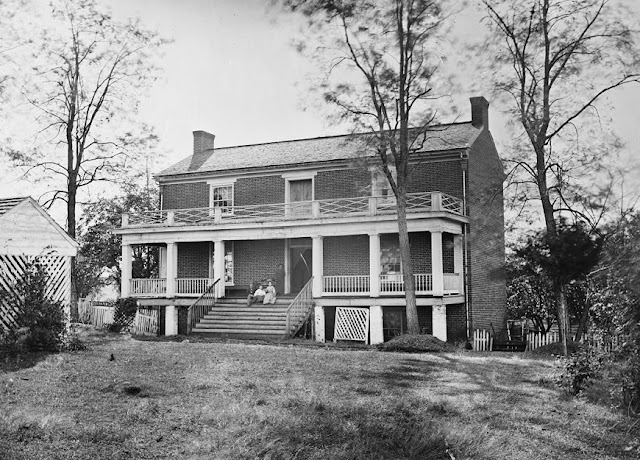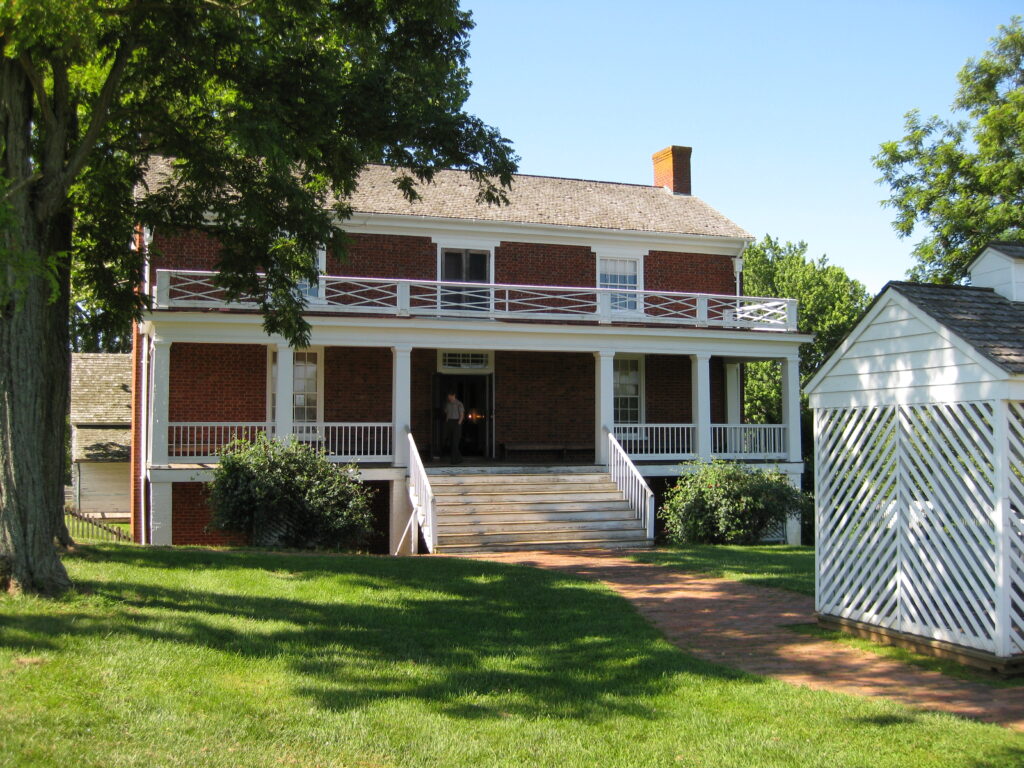Situated near the center of Appomattox, Virginia, the McLean House stands as a handsome but otherwise unremarkable home. Constructed of brick and adorned with a charming white porch, the home offers no hints of its importance. But walk towards the home, passing through the white picket fence and shadows of the stately oak trees, and you’re following in the footsteps of legends. For it was in the parlor of the McLean House that General Robert E. Lee surrendered his Army of Northern Virginia to General Ulysses S. Grant, effectively ending the Civil War.


Preserved as part of Appomattox Court House National Historical Park, the McLean House has to be considered one of the nation’s most significant historic landmarks. I’ve wanted to visit for a while and it certainly didn’t disappoint. Standing in the front yard of the McLean House it’s impossible not to indulge your imagination. How would the scene have looked on April 9, 1865? What was the atmosphere like when General Robert E. Lee rode into Appomattox on his favorite horse, Traveller, and dismounted in front of the McLean House? Impeccably dressed in a crisp gray uniform, sporting a sash and dress sword, Lee was the epitome of formality. A prominent member of Virginia’s landed aristocracy, Lee must have entertained thoughts about how the world was about to change as he sat in the parlor waiting for General Grant.
The arrival of General Grant must have been equally dramatic. Arriving on his prized horse Cincinatti, Grant surely knew he was about to be immortalized. To be forever remembered as the man who defeated the Confederacy. Dressed in an informal uniform with mud caked on his boots, Grant’s appearance was a stark contrast to Lee’s formal attire. I suppose that was entirely appropriate given the relative trajectory of their lives. Grant, representing one of America’s great rags to riches stories, was about offer surrender terms to one of the most privileged men in American history. I would have been disappointed if he didn’t to do it with mud on his boots.

While the lead up to the surrender must have been a sight to see, the surrender itself was pretty remarkable. First off, the fact that the McLean House hosted the surrender is one of the Civil War’s great coincidences. The home’s namesake Wilmer McLean had moved his family to Appomattox in 1863 precisely to escape the Civil War. The First Battle of Bull Run, where the Union and Confederate armies met for the first time, was fought near McLean’s plantation in Manassas, Virginia. During the battle, the McLean family home had served as the headquarters of Confederate General Beauregard. The coincidence gives rise to the observation that the Civil War started in Wilmer McLean’s backyard and ended in his parlor.
While it didn’t occur at the McLean House, there’s another coincidence related to the surrender, that makes for an interesting bit of symbolism. In March 1865, with the Confederacy nearing collapse, General Grant invited President Lincoln to meet at his headquarters in City Point, Virginia, which lay on the banks of the James River. City Point has sprung up during the Petersburg campaign, and overnight had become the busiest port in the world, supplying the majority of the Union army.
President Lincoln agreed to meet in City Point, where he conveyed to Grant his wish that surrender terms should be generous when the time came. Most of these conversations actually took place aboard the steamship River Queen, but the fact that they happened near City Point is an underappreciated coincidence. For directly across the James River, stood the Shirley Plantation, the first plantation established in Virginia, and the place where Robert E. Lee spent much of his childhood.
Gazing across the James River from the site of Grant’s City Point headquarters, it’s not difficult to reach a similar conclusion to that of the Mclean coincidence. For it was just down the river at Point Comfort, today’s Fort Monroe, that the first slaves landed in America during August 1619. Now the military supplies pouring out of the North’s industrial centers were being shipped up the James River and offloaded at City Point. Maybe it’s a bit of a stretch, but it’s worth considering the alternative conclusion that the Civil War began and ended in the James River. It’s certainly a less direct observation but it’s interesting to think about.
Finally, the surrender meeting itself produced a pretty amazing moment. The formal terms of surrender were written by Lieutenant Colonel Ely Parker, a member of General Grant’s staff, and a Seneca Indian. During the meeting General Lee remarked, “I am glad to see one real American here.” To which Lieutenant Colonel Parker replied, “We are all Americans here.” How amazing is that? That exchange might be the perfect embodiment of Lincoln’s desires for peace, first expressed aboard the “River Queen”. In the context of a surrender preceded by five years of war and 600,000 dead, Parker’s response might be one of the most profound statements of national unity in American history.
The surrender at Appomattox represents a seminal moment in American history, one further romanticized by the coincidences and symbolism surrounding the event. It isn’t glorified in the same way as the American founding, but I think the surrender at Appomattox represents the rebirth of the nation. Not only would the North and South be reunited as a single nation, but the question of whether slavery would exist in that nation was also settled. The implications of the Appomattox surrender might best be summarized by the New York Sun’s headline for the event, “Our Nation Redeemed”.
Visiting Appomattox Court House National Historical Park
Appomattox is located in central Virginia, twenty miles east of Lynchburg. For anyone who enjoyed my post on the National D-Day Memorial, the two are only 45 minutes away from each other. You can easily see both in the same day.
The National D-Day Memorial – A Day In Bedford, Virginia – Trip Across America
While the McLean House is the park’s main attraction, there’s plenty more to see. The village of Appomattox Court House has been reconstructed to appear just as it did in 1865, with many of the buildings being original (restored). One of my favorite buildings is the Clover Hill Tavern, where a printing operation was quickly setup to print parole passes for the former Confederate soldiers. The printers worked non-stop to produce over 30,000 paroles. The tavern is original, and you can see a reconstruction of the printing operation inside.
The park is one that you can easily see in a single day. Realistically most people only need a couple hours to see pretty much everything. The courthouse has been rebuilt in the center of the village and serves as the park’s visitor center. Inside there are some museum exhibits as well as a theatre that plays a short movie, which is worth watching. But for most people a tour of the McLean House is going to be the highlight of any visit. It’s tough to beat the main attraction.
Appomattox Court House National Historical Park (U.S. National Park Service) (nps.gov)

What a great summation, Zach. I love US history and your writing always makes it come alive. I enjoy living vicariously through your travels.